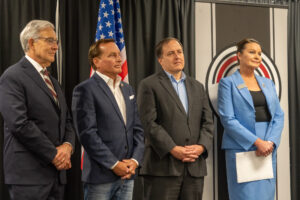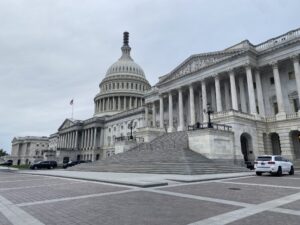5:30
News Story
Groups work to energize Missouri’s Black voters in election’s final weeks
With efforts by political parties and statewide candidates falling short, local organizations focus on turnout
All summer and into the fall, the Rev. Michelle Higgins has set aside any thought of leisurely weekends with her family. Instead, she and her two children have been out knocking on doors.
“My children’s weekend outings are canvassing and getting to know neighbors around our church building for a specific purpose — and that is our survival,” said Higgins, pastor of St. John’s Church in North St. Louis City and one of the founders of Action St. Louis, a grassroots racial justice organization.
“I have to believe that my people are gonna show up,” she said. “And a part of my ability to believe it is that I’ve seen it.”
Higgins isn’t alone. Like thousands of others around the state, she’s dedicating huge swaths of time, not because she’s getting paid by either political party or any candidates. Instead, she’s part of a network of paid canvassers and volunteers trying to energize Black voters and get them to the polls.
“It’s absolutely game changing for voters in the Black community,” said Michael Butler, St. Louis Recorder of Deeds and former chairman of the St. Louis Democratic Central Committee.
“They are doing the work from a lens that is based in racial equity and putting Black voters first,” he said. “As long as that is the case, that is the best vehicle for Black voter turnout. They have done more for Black voters than the Missouri Democratic Party has done in 50 years. And I’m happy about it.”
Political observers agree that huge turnout among Black voters would have a major impact on statewide elections in Missouri. But have candidates or political parties done enough to ensure those voters cast a ballot? From elected officials to grassroots organizers, the answer is a resounding “no.”
With that dynamic in mind, an undercurrent of young Black strategic organizers who are running an aggressive and effective canvassing effort have stepped in — completely outside of any party or candidate’s coordinated efforts.
There are now 150 local organizations moving under the umbrella of the St. Louis-based Movement for Black Lives’ Electoral Justice Voter Fund project — which launched in October 2017. The voter project is educating voters on the absentee-ballot process and explaining that voting is a tool for change, Higgins said.
“We are organizers who are making lead organizers out of every block captain, every Grandma, every cousin to do what’s right,” Higgins said.
About half of Missouri’s Black voters live in the 1st Congressional District, which encompasses all of St. Louis and much of North St. Louis County. It’s the district where Ferguson frontliner and nurse Cori Bush is likely to become Missouri’s first African-American woman elected to Congress after an August Democratic primary upset of long-time incumbent U.S. Rep. Lacy Clay in a race that garnered national attention.
The next largest bloc is the 23 percent of Black voters who live in the 5th Congressional District, which includes Kansas City. Out of Missouri’s 4.2 million voters, about 515,000 are Black, according to a U.S. Census Bureau survey following the November 2018 election.
More than 80 percent of Black voters will support Democratic candidates, according to the Pew Research Center.
In 2008, Barack Obama was the last Democratic presidential nominee to come close to winning in Missouri. Black turnout statewide was 73.5 percent, according to the Census. In 2016, it was 65.5 percent.
“If you really want a record turnout of Black voters — which is what you need to win in Missouri — then you are going to have to electrify the African-American community,” said Charlene Jones, a political science professor at Harris Stowe-State University. “And you do that by letting them know that you are staunchly supportive of the issues they think are important.”
State Sen. Karla May, D-St. Louis, has knocked on thousands of doors in majority-Black areas in St. Louis alongside other St. Louis elected officials, clergy, the St. Louis City NAACP and other organizations to register voters and increase the 2020 Census response.
Statewide Democratic candidates, she said, are not visible.
“It feels like the same thing that has always happened in the past,” May said. “I think that the Democratic Party and Democratic candidates take their base for granted because it’s a certain way you have to campaign to African-American voters. And that’s just the fact of the matter.”
Ground game

Higgins and others say they are using the same targeted, strategic door-knocking in low-voter turnout neighborhoods and phone banking that helped Bush, St. Louis Treasurer Tishaura Jones and Circuit Attorney Kim Gardner win their August primary races handedly.
Since mid-September, they’ve knocked on 25,000 doors to register voters.
Voter turnout in the city’s August primary was almost 40 percent, compared to 26.7 percent in 2016’s primary. The city’s voter turnout was 69.4 percent in the 2016 general election.
When asked if the Missouri Republican Party was specifically targeting Black voters to get them out to the polls, Executive Director Jean Evans said that the party doesn’t focus on one ethnic group. Gov. Mike Parson’s campaign did not respond to The Missouri Independent’s request for comment.
There are three things candidates need to do to energize Black voters, said Jones, whose strategy for a strong ground game has been used successfully in St. Louis elections for decades.
First, candidates need to publicly ask for the Black community’s vote. Second, they need to be visible on the ground, particularly knocking on doors and answering questions. And third, if challenged for supporting issues important to the Black community, such as addressing systemic racism in the police department, they need to remain firm.
If Democrats want record turnout from their historically most loyal voters, they need to do better on all three points, Jones said. While gubernatorial candidate Nicole Galloway has been praised for sitting down with Black leaders to form a comprehensive Black agenda, that message isn’t resonating in the community, she said.
The two top-ticket races on the Democratic ballot — the Biden/Harris campaign and Galloway for governor — have not been door knocking because of the pandemic, according to their campaigns.
GET THE MORNING HEADLINES.
“We made a decision many months ago that we weren’t going to knock on doors and we were going to do so for the public health of both our volunteers and the communities,” said Chris Sloan, Galloway’s campaign manager. “But that hasn’t altered the number of persuasive conversations that we’ve had with voters, especially in St. Louis and North St. Louis.”
This is a huge missed opportunity, said Rosetta Okohson, founder and CEO of MO Political Consulting. Her team of 40 canvassers and growing are knocking on doors for state Rep. Paula Brown, state Rep. Trish Gunby and Tishaura Jones, and they’ve stood on the sidewalk to talk with voters. They’ve had an unprecedented 42 percent contact rate because people are largely at home.
“We’ve been thanked countless times,” Okohson said. “They are foaming at the mouth to have a conversation that’s not with their family member.”
Lessons learned
For many, Claire McCaskill’s unsuccessful November 2018 re-election campaign for U.S. Senate has now become an example of what happens when statewide candidates distance themselves from Black voters to try and win rural white voters.
“Claire McCaskill lost because of Claire McCaskill,” Jones said. “She bragged about spending the majority of her time campaigning in rural Missouri. Rural Missouri had no interest in supporting her, but she was so determined in going after the white vote, instead of the people who supported her consistently.”
McCaskill did not respond to a request for comment. But last week she tweeted that in 2006, 79 percent of the “St. Louis city/African American/urban core” voted for her, or 75,183 votes. And in 2018 that increased to 84 percent and 96,828 votes.
“We knocked on more doors than any other campaign in the country,” her tweet stated. “We had record turnout and margins in the blue areas of the state. We lost because there was also a huge turnout for Trump who camped out here.”
Clem Smith, acting chair of the Missouri Democratic Party, said he hopes candidates have learned from previous campaigns.
“I say this all the time (to candidates), ‘You can’t come last minute with chicken plates and inspirational speakers, and then somehow think you’re going to win over the hearts and minds of Black voters,” Smith said. “You’ve got to have points of contact consistently, and Black people have to know that you’re genuine in what you’re saying.”
But there is no comparison of McCaskill to Galloway, said Okohson.
“It’s apples and oranges,” she said.
Galloway has a Black agenda that includes criminal justice reform, economic empowerment, a ban on discrimination and health care as a human right. She’s held virtual town halls with various groups, including high school coaches in North St. Louis, Black businesses and grassroots organizations. She’s helping to organize the Souls to the Polls effort.
Galloway’s ground game looks different because of the pandemic, said Cal Harris, senior advisor for Galloway’s campaign who is from North St. Louis City. In fact, it has pushed them to be more innovative in their use of texting, virtual events and social media outreach.
The lack of door knocking has “nothing to do with not engaging Black voters,” he said.
“I have a 17 month old,” Harris said. “We have to make sure everyone’s safety comes first.”
While Bush also refrained from knocking doors for a time, her campaign made a strong push before the August primary. She’s since done a statewide tour to stump for Galloway.

Several organizers say her presence on the ballot — in the congressional district with the state’s largest population of Black voters — could be a boon for other Democrats up and down the ballot.
“There’s a recognition across the state that Cori Bush has a role to play in generating voter enthusiasm, not just in the first district but across the state,” said her spokesperson, Keenan Korth.
Bush told her story to a small group of people who listened and ate hot dogs on the lawn of St. John’s Church in North St. Louis at an event last week. At one point, she was living out of a car with her two children and couldn’t understand how she got there.
“I got to see the holes in our system,” Bush said, then quoting a friend and likely congressional colleague added that “those closest to the pain should be closest to the power.”
“And so that’s what I’m taking with me to D.C.,” Bush said, “is the pain and struggle that we’ve had to live through here and a lot of it from complacent leadership.”
This story has been edited since publication to reflect official voter registration numbers in St. Louis city.
Our stories may be republished online or in print under Creative Commons license CC BY-NC-ND 4.0. We ask that you edit only for style or to shorten, provide proper attribution and link to our website. AP and Getty images may not be republished. Please see our republishing guidelines for use of any other photos and graphics.





